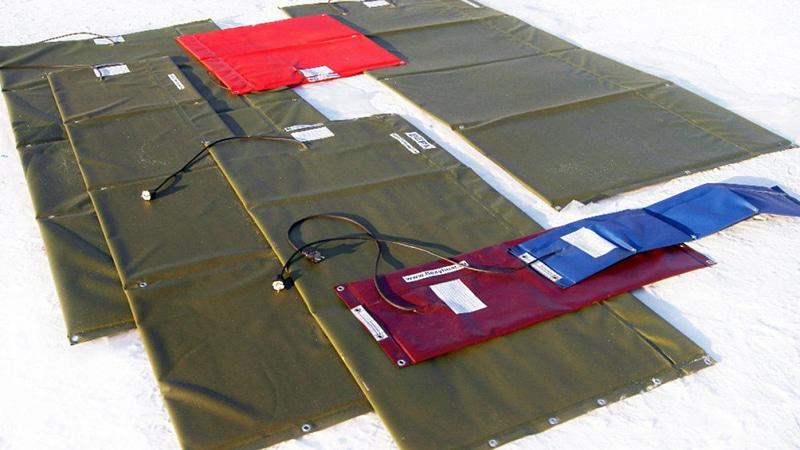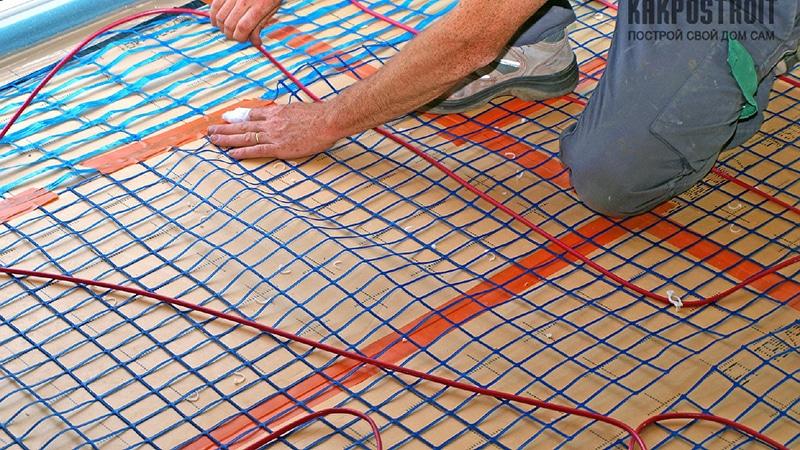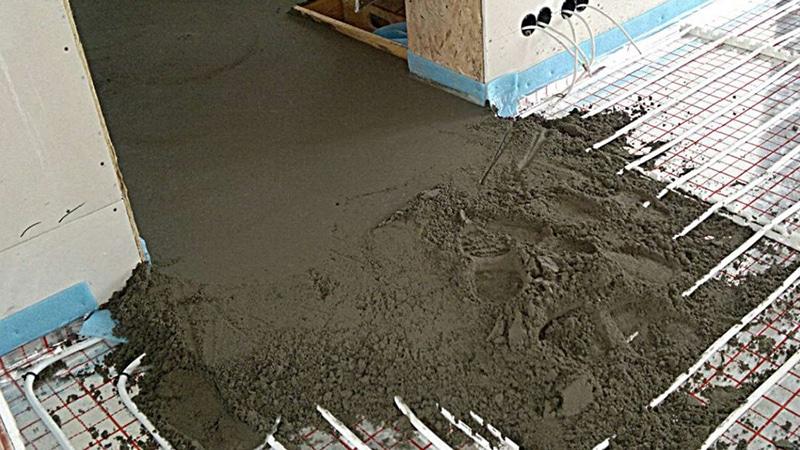Sections of the site
Editor's Choice:
- How to unlock ariston washing machine
- Pros and cons of LED lighting
- Pulse relay: device and connection
- How to calculate the illumination of a room with LED lamps?
- Plastic box - do-it-yourself aesthetic view of electrical wiring
- Electricity consumption of a warm floor: electric and film
- Installing a pump in a well: how to properly install pumping equipment
- Electrician Toolkit Overview
- How to choose a water heater: the most complete list of evaluation criteria
- 1 acoustics on the example of Sven SPS-860 and Realtek ALC889 codec
Advertising
| Do-it-yourself electric underfloor heating for tiles |
|
Not so long ago, before laying floor tiles, many people thought about the further comfort of using the floor covering. After all, even in the summer, the floor was unpleasantly cold. This is due to the high heat-conducting properties of ceramics. Today, you can benefit from this lack of tile by installing an electric underfloor heating system under the cladding. This innovation will ensure a uniform and stable temperature in the room even in the absence of central heating in it. Classification of electrical heating systemsIt must be said that underfloor heating device tiles will help to permanently solve the problem with unpleasant dampness and coolness in the apartment in autumn and spring, when it is still not hot outside, but the central heating has already been turned off. Such systems are able to operate all year round completely autonomously and without restrictions. Besides, underfloor heating cable electric under the tile can become an alternative source of heat, in addition to the main one, for example, for residents of private cottages. The ability to control the temperature is an additional advantage of an electric heating system over a water-heated floor. Equipping the bathroom with a floor heating system will significantly increase the comfort of its operation. To date, there are such varieties of it:
To figure out which type of heating structure will be optimal for a particular floor covering, you need to consider in more detail each of the types of systems. Cable underfloor heatingOften during the renovation of the bathroom, many owners wonder, where to buy high-quality electric underfloor heating for tiles, which ones are better to choose and easier to install. It's hard to answer for sure. Cable systems require laying under a cement screed with a height of at least 35 mm. Given the thickness of the cable itself, you will lose about 6-8 cm of the total height of the room. In addition, additional concrete coating increases the load on the floor slabs. However, for a bathroom, this option is acceptable, since its small area allows the installation of such a design.
Schematic representation of a two-core cable Cable underfloor heating can be single-core or two-core. In the case of self-installation, it is better to stop at the second option. Such a system is much easier to install, and also works when only one end is connected. ThermomatsSuch systems are made of fiberglass with a uniform distribution of heating elements on it. Thermomats will be an excellent solution to the problem of how to make an electric underfloor heating with your own hands under a laminate or tile. Since their installation does not require an additional screed, as in the first case. However, the high cost of such structures and the need to call professionals to carry out the installation make this type of heating system not so attractive.
Warm systems of thermomats are mounted easier than cable structures Film Type Infrared HeatersThe answer to the question of which do-it-yourself electric underfloor heating under linoleum or laminate will be the best choice, we can safely say that film heating structures in this case will be the best option. The infrared radiation coming from the elements heats the surface, leaving them cold. This property is very important for fire hazardous floor coverings. In addition, such systems can significantly save energy consumption.
This is how the installation of infrared film structures looks like The thickness of the base made of polymers is about 0.4 mm, and it can also be laid on any base, thereby allowing you to leave the height of the room unchanged. However, the complexity of installing a film heating system under a tile makes it not the best option for a bathroom. Positive and negative characteristics of electric underfloor heatingTo finally clarify for yourself, electric underfloor heating under the tile, which one is better, you need to know the advantages and disadvantages inherent in these designs. Here you should listen to the opinion of the owners who have already installed this or that type of system. Typically, the advantages of these heating elements include the following characteristics:
The combination of advantages of electric underfloor heating indicates the feasibility of installing such a system in the bathroom. However, it is worth learning about the shortcomings of these designs. As a rule, they include such nuances: In a word, electric underfloor heating under tiles, the pros and cons of which are described above, can be a reasonable alternative to central heating during the cold season and increase the comfort of using the bathroom during this period. To find out how to lay an electric underfloor heating under the tiles with your own hands in the bathroom correctly, you should heed the advice of specialists in the installation of these structures. The best option for laying the bathroom will be a cable floor heating system. Initial stage of workYou should start by calculating the required system power for your room. The minimum value for rooms with high humidity is 150 W per square meter of coverage area. You also need to draw up an approximate scheme for laying the cable and the location of the temperature sensor.
Wall chasing for sensor installation
Then you should prepare a place in the wall as close as possible to the floor plane for holding a corrugated hose through which you will connect the equipment. One end of the pipe should go to the installation site of the system, and the other - to the sensor equipment. In the event of a breakdown of the devices, it will be much easier to replace them if you lay the corrugated pipe following these recommendations. Remember that its location must be uniform with respect to all turns of the heating cable. In addition, the bend of the hose in the corner should be smooth, it is recommended to provide for its radius of at least five centimeters. Laying and fixing thermal insulationAt this stage of work, you need to collect all the debris from the floor and mark the cable laying areas. Underfloor heating is installed only in places where there is no plumbing and furniture. A heat-insulating coating should be laid there, the thickness of which should be at least 4 mm. It must be taken into account that the thermal insulation layer slightly extends onto the walls of the room, and subsequently the excess substrate can be easily cut off.
It is better to choose a foil substrate, since the amalgam reflects thermal radiation well Mounting tape will help fix the coating. You need to lay it in increments of about sixty centimeters. It is reinforced with dowels through the substrate layer. Heating cable installationExperts advise starting the laying of heating elements from the place where they are connected to the power source. Care must be taken during installation so as not to damage the cable. Therefore, you should try not to step on the turns of wires and it will be preferable to work in soft shoes.
It is also worth considering that the gap from the walls to the edges of the cable should be approximately 7 cm.
Care must be taken when laying the cable so as not to damage the system. One of the ends of the cable must be plugged with a special nozzle that comes with the system. Next, you should fix the turns of the heating elements. Then we lay a corrugated hose, observing all the conditions necessary for this, and display the temperature switch at the planned place. After that, you can connect the system to the power cable and check its operation. Please note that during normal operation of the structure, the wires will only slightly heat up. To determine the ability to work, it is enough to connect the system for 20–40 seconds. We fill the screed correctlyAfter completing the installation of the heating elements, you can proceed to pouring the floor with a concrete mixture. To do this, you need to prepare the required amount of mortar in order to put a screed of the required thickness immediately over the entire area of \u200b\u200bthe room. The minimum allowable coating layer is four centimeters, but you can increase it if you wish. It is important to know that a large thickness of the screed will warm up much more slowly, but at the same time it is able to retain heat longer. Do not turn on the floor heating system until the concrete coating is completely dry. Failure to comply with this rule can lead to violations of the tightness of the cement base and the warm floor, which will lead to incorrect operation of the structure in the future. It should be noted that the correct proportions of the dilution of the cement mortar and the time for its complete curing depend on the specific manufacturer. Therefore, here you need to carefully study the instructions for using the finished mixture.
It is very important to cover the underfloor heating cable system with a layer of cement mortar of the required thickness. On a completely dry and hard surface of the screed, you can proceed with ceramic tiling. First of all, the thermal insulation substrate protruding onto the walls should be cut along the line of the cement floor. Then, lay the tile, as on an ordinary floor. The speed and quality of the lining will depend on the quality of the concrete base.
In a similar way, it is also possible to lay a film heating system and thermomats. Following these recommendations will help to carry out quality work on laying the warm floor in the bathroom. The result will pleasantly surprise you and your guests, as well as increase the comfort of visiting the bathroom in the cold season. Equipping a bathroom with a floor heating system will significantly increase the comfort of its operation. so as not to damage the system The cable should be securely fixed in order to avoid problems in the future It is very important to cover the underfloor heating cable system with a layer of cement mortar of the required thickness It is necessary that the distance between the turns be at least eight centimeters the consistency of the solution, you need to carefully study the manufacturer's instructions |
New
- I am a big tea lover. I especially respect green
- Ivan-tea with the addition of mint The chemical composition of the plant
- What is useful wheat porridge for the body
- Recipe: Soy Schnitzel - An excellent and tasty substitute for meat during Lent
- How to make ginger tea
- Coconut manna: benefits and harms, recipes with organic product Coconut paste how to use
- "Healthy" vegetable oils - a possible cause of obesity
- Adnexitis: causes, symptoms and treatment of the disease
- Herpes during pregnancy. Types, symptoms, treatment. Treatment of herpes during pregnancy Ointment for herpes during pregnancy
- What is pink catharanthus and how to care for it?













